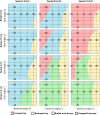Manual wheelchair downhill stability: an analysis of factors affecting tip probability
- PMID: 30400911
- PMCID: PMC6219167
- DOI: 10.1186/s12984-018-0450-3
Manual wheelchair downhill stability: an analysis of factors affecting tip probability
Abstract
Background: For people who use manual wheelchairs, tips and falls can result in serious injuries including bone fractures, concussions, and traumatic brain injury. We aimed to characterize how wheelchair configuration changes (including on-the-fly adjustments), user variables, and usage conditions affected dynamic tip probability while rolling down a slope and contacting a small block.
Methods: Rigid body dynamic models of a manual wheelchair and test dummy were created using multi-body software (Madymo, TASS International, Livonia, MI), and validated with 189 experiments. Dynamic stability was assessed for a range of seat angles (0 to 20° below horizontal), backrest angles (0 to 20°), rear axle positions (0 to 20 cm from base of backrest), ground slopes (0 to 15°), bump heights (0 to 4 cm), wheelchair speeds (0 to 20 km/hr), user masses (50 to 115 kg), and user positions (0 to 10 cm from base of backrest). The tip classifications (forward tip, backward tip, rolled over bump, or stopped by bump) were investigated using a nominal logistic regression analysis.
Results: Faster wheelchair speeds significantly increased the probability of tipping either forward or backward rather than stopping, but also increased the probability of rolling over the bump (p < 0.001). When the rear axle was positioned forward, this increased the risk of a backward tip compared to all other outcomes (p < 0.001), but also reduced the probability of being stopped by the bump (p < 0.001 compared to forward tip, p < 0.02 compared to rolling over). Reclining the backrest reduced the probability of a forward tip compared to all other outcomes (p < 0.001), and lowering the seat increased the probability of either rolling over the bump or tipping backwards rather than tipping forward (p < 0.001). In general, the wheelchair rolled over bumps < 1.5 cm, and forwards tipping was avoided by reducing the speed to 1 km/hr.
Conclusions: The probability of forward tipping, corresponding to the greatest risk of injury, was significantly reduced for decreased speeds, smaller bumps, a reclined backrest, and a lower rear seat height. For wheelchairs with dynamic seating adjustability, when travelling downhill, on-the-fly adjustments to the seat or backrest can increase the likelihood of safely rolling over a bump.
Keywords: Mobility devices; Motion capture; Rigid body dynamics; Simulation; Wheelchair stability.
Conflict of interest statement
Ethics approval and consent to participate
Not applicable.
Consent for publication
Not applicable.
Competing interests
JB is a product consultant to PDG Mobility, the manufacturer of the ElevationTM wheelchair. In addition, JB has a financial interest in the sale of the ElevationTM wheelchair product and is named on the following patents related to the ElevationTM wheelchair: US 7,950,684, US 7,845,665, US 8,042,824, US 8,801,020. LT and CJS declare that they have no competing interests.
Publisher’s Note
Springer Nature remains neutral with regard to jurisdictional claims in published maps and institutional affiliations.
Figures






Similar articles
-
The dynamics of electric powered wheelchair sideways tips and falls: experimental and computational analysis of impact forces and injury.J Neuroeng Rehabil. 2016 Mar 2;13:20. doi: 10.1186/s12984-016-0128-7. J Neuroeng Rehabil. 2016. PMID: 26935331 Free PMC article.
-
Quantifying the effects of on-the-fly changes of seating configuration on the stability of a manual wheelchair.Annu Int Conf IEEE Eng Med Biol Soc. 2017 Jul;2017:1897-1900. doi: 10.1109/EMBC.2017.8037218. Annu Int Conf IEEE Eng Med Biol Soc. 2017. PMID: 29060262
-
Characterizing the community use of an ultralight wheelchair with "on the fly" adjustable seating functions: A pilot study.PLoS One. 2017 Mar 9;12(3):e0173662. doi: 10.1371/journal.pone.0173662. eCollection 2017. PLoS One. 2017. PMID: 28278254 Free PMC article.
-
Aspects of manual wheelchair configuration affecting mobility: a review.J Phys Ther Sci. 2014 Feb;26(2):313-8. doi: 10.1589/jpts.26.313. Epub 2014 Feb 28. J Phys Ther Sci. 2014. PMID: 24648656 Free PMC article. Review.
-
Special considerations in the selection of the certified rehabilitation supplier.J Long Term Eff Med Implants. 2004;14(6):513-9. doi: 10.1615/jlongtermeffmedimplants.v14.i6.60. J Long Term Eff Med Implants. 2004. PMID: 15698377 Review.
Cited by
-
Evaluation of Power Wheelchair Dynamic Suspensions for Tip Prevention in Non-ADA Compliant Surfaces.Arch Phys Med Rehabil. 2023 Dec;104(12):2043-2050. doi: 10.1016/j.apmr.2023.05.016. Epub 2023 Jun 16. Arch Phys Med Rehabil. 2023. PMID: 37329969 Free PMC article.
-
Influence of Wheelchair Type on Kinematic Parameters in Wheelchair Rugby.Front Sports Act Living. 2022 Jun 3;4:861592. doi: 10.3389/fspor.2022.861592. eCollection 2022. Front Sports Act Living. 2022. PMID: 35721878 Free PMC article.
-
A Systematic Methodology to Analyze the Impact of Hand-Rim Wheelchair Propulsion on the Upper Limb.Sensors (Basel). 2019 Oct 25;19(21):4643. doi: 10.3390/s19214643. Sensors (Basel). 2019. PMID: 31731458 Free PMC article.
-
Perspectives of wheelchair users with spinal cord injury on fall circumstances and fall prevention: A mixed methods approach using photovoice.PLoS One. 2020 Aug 28;15(8):e0238116. doi: 10.1371/journal.pone.0238116. eCollection 2020. PLoS One. 2020. PMID: 32857793 Free PMC article.
References
-
- Sapey B, Stewart J, Donaldson G. The social implications of increases in wheelchair use. Dep Appl Soc Sci Lanc Univ. 2004. https://disability-studies.leeds.ac.uk/wp-content/uploads/sites/40/libra....
-
- Van Drongelen A, Roszek B, Hilbers-Modderman E, Kallewaard M, Wassenaar C. RIVM repos. 2002. Wheelchair incidents.
Publication types
MeSH terms
LinkOut - more resources
Full Text Sources
Medical

